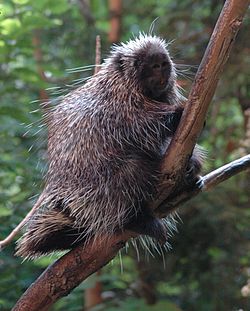| Erethizontinae | |
|---|---|
 | |
| North American porcupine (Erethizon dorsatum) | |
| Scientific classification | |
| Domain: | Eukaryota |
| Kingdom: | Animalia |
| Phylum: | Chordata |
| Class: | Mammalia |
| Order: | Rodentia |
| Family: | Erethizontidae |
| Subfamily: | Erethizontinae Bonaparte, 1845 |
| Genera | |
Erethizontinae is a subfamily of the New World porcupine family Erethizontidae, [1] and includes all species of the family with the exception of the bristle-spined rat, Chaetomys subspinosus, which is classified in its own subfamily, Chaetomyinae.